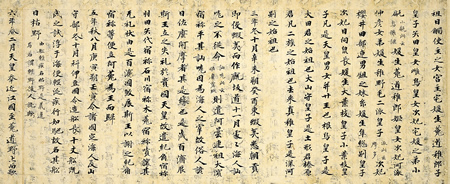 |
| Kojiki and Nihon Shoki |
Kojiki means Record of Ancient Matters and Nijon Shoki means Chronicles of Japan. They were written in 712 and 720, respectively, and are the earliest works of Japanese myth and early history based on ancient oral traditions. They were produced on orders of the government to exalt the ruling imperial line that claimed descent from the sun goddess through the Yamato clan that ruled Japan.
These two works are the earliest extant works on early Japan, from the creation of the cosmos, the mythology of the deities and the beginning of Japanese history, working forward toward verifiable history. Their background is the massive borrowings from the advanced Chinese civilization beginning in the sixth century.
They included the introduction of Buddhism from China via Korea in the mid-sixth century and accelerated under the leadership of Prince Shotoku Taishi (r. 596–622), who was an enthusiastic Buddhist and also an admirer of Confucius and the great Chinese empire under the Sui dynasty and Tang (T’ang) dynasty. He sent three embassies to China to learn its ways and ideals, which included great reverence for history. Since there was no indigenous written Japanese, Japan adopted the Chinese written script.
  |
The advantage is that educated Japanese gained access to nearly 2,000 years of Chinese literary and historic tradition. Prince Shotoku reputedly began to compile the first history of Japan in 620, but that work was lost during a political upheaval after his death; hence another effort was ordered late in the seventh century, with two simultaneous works as a result.
Both works begin with creation, which they divided into three stages. The first stage involved the creation of heaven, earth, Japan, and the first kami (deity). The second stage saw the birth of the sun goddess Amaterasu, who was the ancestor of the imperial clan, and her unruly brother (ancestor of a rival clan).
The third stage dealt with Amaterasu’s dispatch of her grandson to rule Japan with instructions to pass the throne to her descendants thus linking the imperial clan to the sun goddess. The Kojiki is the shorter of the two, with only three volumes, and ends in 628 with the death of Empress Suiko. It is mainly devoted to mythology and ancient history and interestingly used a mixture of Chinese and Japanese syntax.
On the other hand the Nihon Shoki is an official history and it is much longer—30 volumes. It was written in the tradition of Chinese dynastic history, chronicling events that began with mythology and giving a detailed genealogy of the Yamato line as descendants of the sun goddess, ending with the abdication of Empress Jito in 697. It was written in literary Chinese and included numerous quotations from Chinese literature.
It also recounted the introduction of Buddhism to the Yamato court by an envoy sent from Korea. The Nihon Shoki set an example of history writing in the Chinese tradition. Just as China had its dynastic histories (there were 24, one for each legitimate dynasty beginning with the Han dynasty, 202 b.c.e.–220 c.e.), five more officially commissioned histories were written of Japan. Together they are called the Six National Histories.